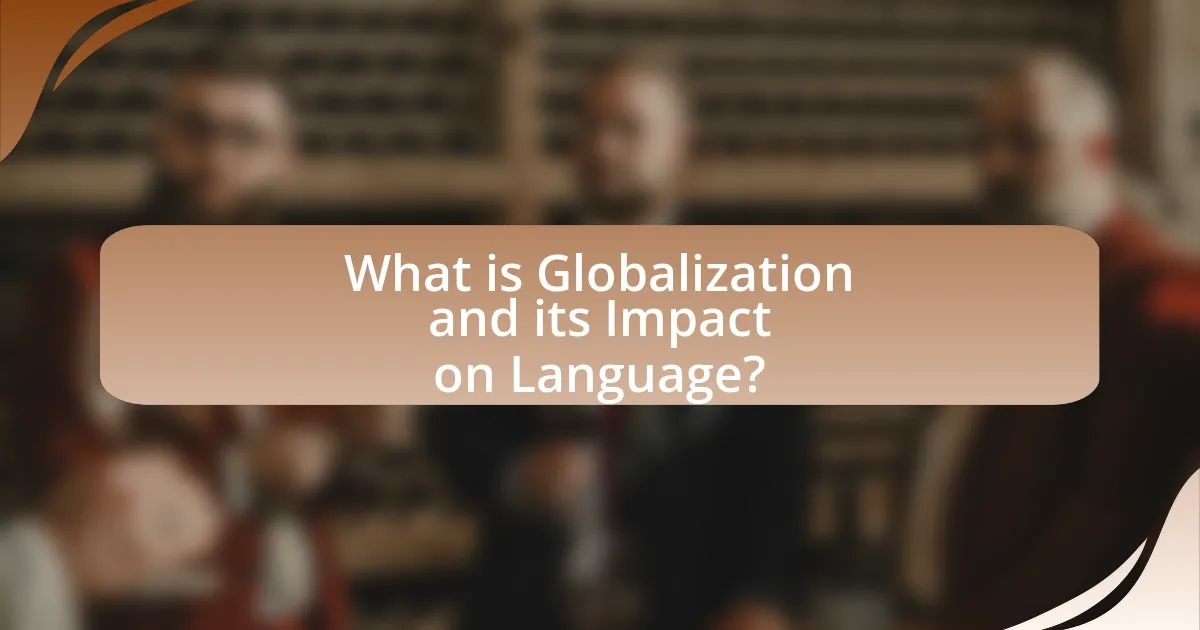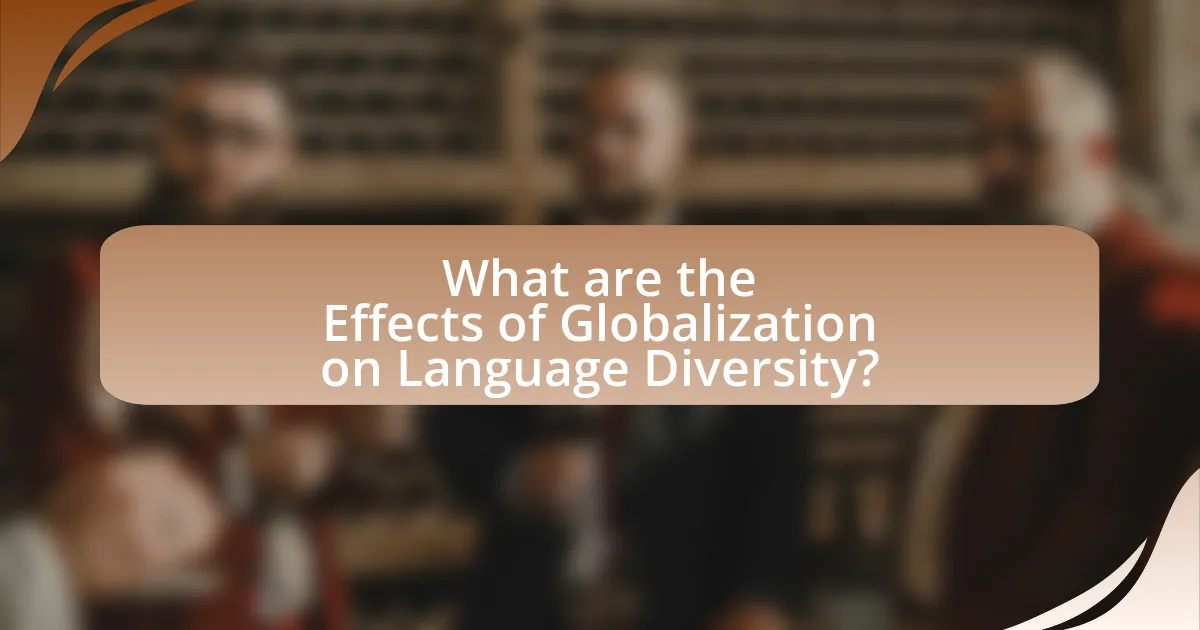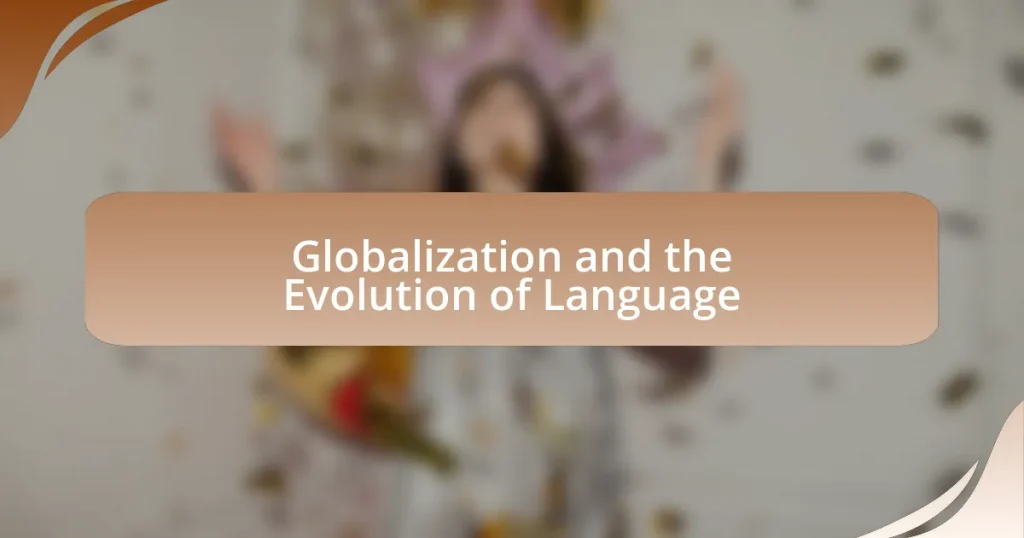Globalization refers to the increasing interconnectedness and interdependence among countries, significantly impacting language by promoting dominant languages like English while threatening the survival of less widely spoken languages. This article examines how globalization influences language development, the key factors driving language change, and the effects on linguistic diversity. It highlights the role of technological advancements, migration, and cultural exchange in shaping language evolution, as well as the importance of understanding these dynamics for cultural identity and social integration. Additionally, the article discusses the mechanisms of language adaptation, the risks faced by endangered languages, and the benefits of maintaining linguistic diversity in a globalized world.

What is Globalization and its Impact on Language?
Globalization is the process of increased interconnectedness and interdependence among countries, primarily driven by trade, technology, and cultural exchange. This phenomenon significantly impacts language by promoting the spread of dominant languages, such as English, while potentially leading to the decline or extinction of less widely spoken languages. According to a report by the United Nations Educational, Scientific and Cultural Organization (UNESCO), over 40% of languages are at risk of disappearing due to globalization, as smaller language communities often adopt more dominant languages for economic and social advantages. This shift can result in language homogenization, where linguistic diversity diminishes, affecting cultural identity and heritage.
How does globalization influence language development?
Globalization significantly influences language development by facilitating the spread of languages and linguistic features across borders. This phenomenon occurs through increased communication, trade, and cultural exchange, leading to the adoption of vocabulary, grammar, and pronunciation from one language into another. For instance, English has become a global lingua franca, impacting local languages worldwide by introducing loanwords and influencing language structures. According to a study by Graddol (2006), the rise of English as a global language has resulted in its integration into various languages, altering their development and usage patterns.
What are the key factors driving language change in a globalized world?
The key factors driving language change in a globalized world include technological advancements, migration patterns, and cultural exchange. Technological advancements, particularly the internet and social media, facilitate rapid communication and the spread of new vocabulary and expressions across different languages. Migration patterns lead to language contact, resulting in code-switching and the emergence of pidgins and creoles as communities blend linguistic features. Cultural exchange through globalization promotes the adoption of foreign words and phrases, influencing local languages and leading to linguistic hybridization. These factors collectively contribute to the dynamic evolution of languages in a global context.
How do technological advancements affect language evolution?
Technological advancements significantly accelerate language evolution by facilitating communication and creating new linguistic forms. For instance, the rise of the internet and social media has led to the emergence of abbreviations, emojis, and new vocabulary that reflect digital culture, such as “selfie” and “hashtag.” Research indicates that these platforms encourage rapid language change, as seen in the widespread adoption of informal language styles and slang across diverse demographics. Additionally, technologies like translation software and language learning apps promote multilingualism and influence language structures, as users adapt their speech to accommodate various languages. This dynamic interplay between technology and language illustrates how advancements reshape linguistic practices and contribute to the ongoing evolution of language in a globalized context.
Why is understanding language evolution important in the context of globalization?
Understanding language evolution is crucial in the context of globalization because it reveals how languages adapt and change in response to cultural interactions and technological advancements. As globalization facilitates increased communication and migration, languages undergo significant transformations, leading to the emergence of new dialects and hybrid languages. For instance, the rise of English as a global lingua franca illustrates how language evolution is influenced by economic and social factors, with over 1.5 billion people speaking English worldwide, according to Ethnologue. This evolution impacts identity, cultural preservation, and social integration, making it essential to study these dynamics to navigate the complexities of a globalized world effectively.
What role does language play in cultural identity during globalization?
Language serves as a crucial component of cultural identity during globalization by facilitating communication and the expression of cultural values. As globalization increases interactions among diverse cultures, language becomes a means through which individuals assert their cultural heritage and maintain a sense of belonging. For instance, studies show that bilingualism can enhance cultural identity by allowing individuals to navigate multiple cultural contexts while preserving their native language, which is often tied to their cultural roots. Furthermore, the dominance of global languages, such as English, can lead to both the erosion of local languages and the hybridization of cultural identities, as seen in various regions where local dialects incorporate elements of global languages. This dynamic illustrates how language not only reflects cultural identity but also shapes it in the context of a globalized world.
How does language evolution reflect social changes in a globalized society?
Language evolution reflects social changes in a globalized society by adapting to new cultural influences, technological advancements, and shifting demographics. As societies become more interconnected, languages borrow vocabulary and structures from one another, leading to the emergence of hybrid languages and dialects. For instance, the rise of English as a global lingua franca has resulted in the incorporation of words and phrases from various languages, demonstrating how social interactions shape linguistic development. Additionally, the proliferation of digital communication platforms has accelerated language change, as seen in the widespread use of abbreviations and emojis, which reflect contemporary social dynamics and communication styles. This phenomenon illustrates that language is not static; it evolves in response to the complexities of social interactions in a globalized context.

What are the Effects of Globalization on Language Diversity?
Globalization significantly reduces language diversity by promoting dominant languages, primarily English, at the expense of local languages. As global communication and trade expand, smaller languages face increased pressure to adapt or become extinct; for instance, Ethnologue reports that over 40% of the world’s languages are endangered due to globalization. This phenomenon leads to language shift, where speakers of minority languages increasingly adopt more widely spoken languages for economic and social advantages, resulting in a decline in linguistic variety and cultural heritage.
How does globalization contribute to language endangerment?
Globalization contributes to language endangerment by promoting dominant languages, such as English, at the expense of local and indigenous languages. As global communication and trade increase, communities often adopt these dominant languages for economic and social advantages, leading to a decline in the use of less widely spoken languages. According to a report by the United Nations Educational, Scientific and Cultural Organization (UNESCO), approximately 40% of the world’s languages are endangered, primarily due to the pressures of globalization that favor a few major languages over thousands of others. This shift results in reduced intergenerational transmission of endangered languages, as younger generations prioritize learning dominant languages for better opportunities.
What languages are most at risk due to globalization?
Languages most at risk due to globalization include indigenous languages such as Navajo, Hawaiian, and many others in Africa and the Americas. These languages face extinction as dominant languages like English, Spanish, and Mandarin spread through media, education, and commerce, leading to a decline in native speakers. According to the UNESCO Atlas of the World’s Languages in Danger, over 2,500 languages are currently endangered, with many losing speakers rapidly as younger generations adopt more globally dominant languages for economic and social opportunities.
How can communities preserve endangered languages in a global context?
Communities can preserve endangered languages in a global context by implementing language revitalization programs, fostering intergenerational transmission, and utilizing technology for documentation and education. Language revitalization programs, such as those seen in New Zealand with the Māori language, have shown success in increasing fluency among younger generations. Intergenerational transmission, where elders teach the language to children, is crucial; studies indicate that languages are more likely to survive when spoken at home. Additionally, technology plays a significant role; for instance, mobile apps and online platforms can facilitate language learning and provide resources for speakers, as demonstrated by the success of the Duolingo app in promoting lesser-known languages. These combined efforts create a supportive environment for endangered languages to thrive despite globalization pressures.
What are the benefits of linguistic diversity in a globalized world?
Linguistic diversity in a globalized world enhances cultural exchange, promotes cognitive flexibility, and supports economic growth. By facilitating communication among diverse populations, linguistic diversity fosters mutual understanding and respect, which are essential for collaboration in international contexts. Studies indicate that multilingual individuals often exhibit improved problem-solving skills and creativity, as they can approach challenges from multiple perspectives. Furthermore, businesses that embrace linguistic diversity can access broader markets and cater to diverse consumer needs, leading to increased profitability. For instance, companies that operate in multiple languages can better engage with local communities, resulting in stronger brand loyalty and customer satisfaction.
How does linguistic diversity enhance global communication?
Linguistic diversity enhances global communication by facilitating the exchange of ideas and cultural perspectives among different language speakers. This diversity allows for a richer dialogue, as various languages encapsulate unique concepts and worldviews that can lead to innovative solutions and collaborations. For instance, research indicates that multilingual individuals often demonstrate greater cognitive flexibility, enabling them to navigate and mediate between different cultural contexts effectively. Furthermore, the presence of multiple languages in international forums promotes inclusivity and ensures that diverse voices are heard, which is essential for addressing global challenges.
What cultural benefits arise from maintaining diverse languages?
Maintaining diverse languages fosters cultural identity and heritage, allowing communities to preserve their unique traditions and worldviews. This linguistic diversity enhances cultural expression through literature, music, and art, enriching global culture. For instance, the United Nations Educational, Scientific and Cultural Organization (UNESCO) highlights that languages carry unique knowledge systems and cultural practices, which are vital for sustainable development and social cohesion. Furthermore, research indicates that multilingualism promotes cognitive flexibility and creativity, contributing to innovative thinking within diverse cultural contexts.

How is Language Adaptation Manifested in Globalization?
Language adaptation in globalization is manifested through the emergence of pidgins and creoles, the incorporation of loanwords, and the evolution of language varieties. Pidgins and creoles develop as a means of communication between speakers of different native languages, often in trade or colonial contexts, illustrating how languages blend to facilitate interaction. For instance, Tok Pisin in Papua New Guinea originated as a pidgin English and has evolved into a creole, demonstrating this adaptation process. Additionally, globalization leads to the widespread borrowing of terms from dominant languages, particularly English, into local languages, which reflects cultural exchange and influence. Research indicates that over 60% of new words in many languages are borrowed from English, highlighting the impact of globalization on linguistic evolution. Furthermore, the rise of digital communication fosters the creation of new dialects and language forms, as seen in the use of emojis and internet slang, which adapt traditional language to modern contexts.
What are the mechanisms of language adaptation in a globalized environment?
Language adaptation in a globalized environment occurs through mechanisms such as code-switching, borrowing, and the emergence of pidgins and creoles. Code-switching allows speakers to alternate between languages or dialects depending on context, facilitating communication in multicultural settings. Borrowing involves the incorporation of words and phrases from one language into another, reflecting cultural exchange and the influence of dominant languages, such as English, in global commerce and media. The development of pidgins and creoles arises from the need for communication among speakers of different native languages, often in trade or colonial contexts, leading to new linguistic forms that blend elements from multiple languages. These mechanisms illustrate how globalization influences language evolution and adaptation, as evidenced by the increasing prevalence of English loanwords in non-English languages and the rise of hybrid languages in multicultural urban areas.
How do languages borrow from each other in a globalized context?
Languages borrow from each other in a globalized context primarily through mechanisms such as trade, migration, and digital communication. These interactions facilitate the exchange of vocabulary, phrases, and grammatical structures, often leading to the incorporation of foreign terms into local languages. For instance, English has absorbed numerous words from languages like French, Spanish, and Japanese due to historical trade relationships and cultural exchanges. The Oxford English Dictionary notes that over 60% of English vocabulary has foreign origins, highlighting the extent of linguistic borrowing. Additionally, the rise of the internet and social media accelerates this process, as users adopt and adapt terms from various languages, further enriching their own linguistic repertoire.
What role do pidgins and creoles play in language adaptation?
Pidgins and creoles serve as crucial mechanisms for language adaptation, particularly in multilingual and multicultural contexts. They emerge in situations where speakers of different native languages need to communicate, often due to trade, colonization, or migration. For instance, the development of Tok Pisin in Papua New Guinea illustrates how a pidgin can evolve from a simplified form of English mixed with local languages, facilitating communication among diverse linguistic groups. This adaptation process allows for the blending of linguistic features, creating new grammatical structures and vocabulary that reflect the cultural and social realities of the speakers. The existence of creoles, such as Haitian Creole, further demonstrates how these languages can stabilize and become fully functional in their own right, often serving as a primary language for communities. Thus, pidgins and creoles not only enable communication but also contribute to the linguistic diversity and evolution of languages in response to globalization.
How do global languages evolve through contact with local languages?
Global languages evolve through contact with local languages by adopting vocabulary, grammar, and phonetic features from those languages. This linguistic exchange often occurs in multicultural environments where speakers of different languages interact, leading to phenomena such as code-switching, borrowing, and the creation of pidgins or creoles. For instance, English has incorporated numerous words from languages like Hindi, Spanish, and French due to historical trade, colonization, and migration patterns. Research indicates that approximately 70% of English vocabulary has foreign origins, demonstrating the significant impact of local languages on its evolution.
What are examples of language evolution due to globalization?
Language evolution due to globalization is exemplified by the widespread adoption of English as a global lingua franca. This phenomenon has led to the emergence of various English dialects, such as Indian English and Singaporean English, which incorporate local linguistic features and vocabulary. Additionally, globalization has facilitated the blending of languages, resulting in creole languages like Tok Pisin in Papua New Guinea, which combines English with local languages. Furthermore, the influence of technology and social media has accelerated the creation of new slang and expressions, such as “selfie” and “hashtag,” which have entered multiple languages worldwide. These examples illustrate how globalization actively shapes and transforms languages through cultural exchange and communication.
How does code-switching reflect language adaptation in multicultural societies?
Code-switching reflects language adaptation in multicultural societies by demonstrating how individuals navigate and integrate multiple linguistic and cultural identities. This phenomenon occurs when speakers alternate between languages or dialects within a conversation, often influenced by social context, audience, or cultural norms. Research indicates that code-switching serves as a tool for identity expression and social cohesion, allowing individuals to align themselves with specific cultural groups or to convey nuanced meanings that may not be present in a single language. For example, studies show that bilingual speakers often switch codes to signal solidarity with a particular community or to convey emotions more effectively, highlighting the dynamic nature of language in response to cultural diversity.
What practical steps can individuals take to navigate language changes in a globalized world?
Individuals can navigate language changes in a globalized world by actively engaging in language learning and cultural exchange. This involves taking language courses, using language learning apps, and participating in language exchange programs to enhance their proficiency in multiple languages. Research indicates that bilingualism can improve cognitive flexibility and cultural awareness, which are essential in a globalized context. Additionally, individuals should immerse themselves in diverse linguistic environments, such as traveling or interacting with multilingual communities, to adapt to evolving language trends and practices. This approach not only fosters communication skills but also promotes understanding of different cultures, which is crucial in a globalized society.










